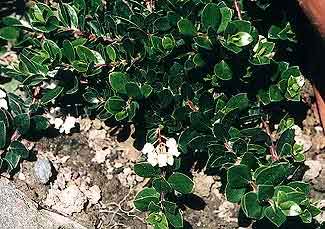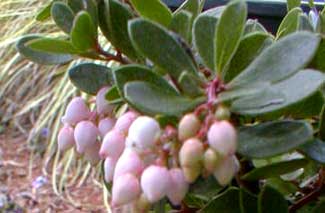
'Emerald Carpet' Manzanita
"The sun has long been set,
The stars are out by twos and threes,
The little birds are piping yet
Among the bushes and the trees."
-William Wordsworth
(1770-1850)
(1770-1850)
Emerald Carpet manzanita is a hybrid of Arctostaphylos uva-ursi (common kinnikinnick or bearberry) & A. nummularia (variously called Glossyleaf Manzanita, Sensitive Manzanita, Shatterberry or Ft. Bragg Manzanita). The latter species gives it its marvelously brilliant green & its exfoliating cinnamon bark, but also makes it less forgiving of very cold or very hot weather compared to regular A. uva-ursi. The common kinnickinnick gives it its prostrate habit & lends it a degree of hardiness beyond that of the Glossyleaf.
 It is the greenest, most compact manzanita cultivar I've seen, with none of the thin or spotty bits that can afflict the majority of the commonly available manzanitas such as 'Vancouver Jade' or 'Massachusetts.' It was our first choice for an extensive woody groundcover along one side of the driveway into SinLur Gardens.
It is the greenest, most compact manzanita cultivar I've seen, with none of the thin or spotty bits that can afflict the majority of the commonly available manzanitas such as 'Vancouver Jade' or 'Massachusetts.' It was our first choice for an extensive woody groundcover along one side of the driveway into SinLur Gardens.Though not hardy everywhere, it is extremely so on Puget Sound & along the Oregon coast to northern California. It was developed at Rancho Santa Ana Botanic Garden, a California native plants research preserve just south of the San Gabriel foothills, & having an especially impressive collection of manzanitas &:amp wild lilacs (Ceanothus spp).
It is a fully evergreen, rarely over a foot tall, but can spread 4 to 6 feet wide. Its attractive exfoliating bark is not easily visible because of the density of its small bright leaves. Bell-shaped flowers are white & usually quite numerous. Ours blooms March through May, though some of the plants wait until April.
It does not require a lot of water, but will not do so well in completely droughty conditions, which would better suit a non-hybrid kinnikinnik. It should be deeply watered every three weeks, & as the shrub spreads wider, the watering should be at the center primarily. It likes full sun but not a lot of heat, & will tolerate shade if need be, will even require some shade if grown inland.
It does not want too rich of a soil but does well in poor sandy soil in exposed areas, in conditions approaching those of coastal sand dunes or pine barrens, & will even do well in clayey soils if not overwatered. A little loaminess may insure the deep emerald green never fades, but its tolerance for richer soils can be exceeded if it's also fertilized, & it may decline. Mulching with leaves or a layer of well composted manure will protect the root against summer heat & winter cold, while at the same time providing it with all the only soil ammendment it ever needs.
The berry-like drupes are unusually large & tasty for a manzanita; I liked them quite a bit. Unfortunately the birds agree, so while the drupes can potentially last on the branches until winter, the birds won't always let them.
Native First Peoples used manzanita roots, leaves, unripe berries, & bark medicinally. Some of the same health claims conferred upon horsetail are also alleged of manzanitas, though the only thing it is certainly good for is as a diuretic.